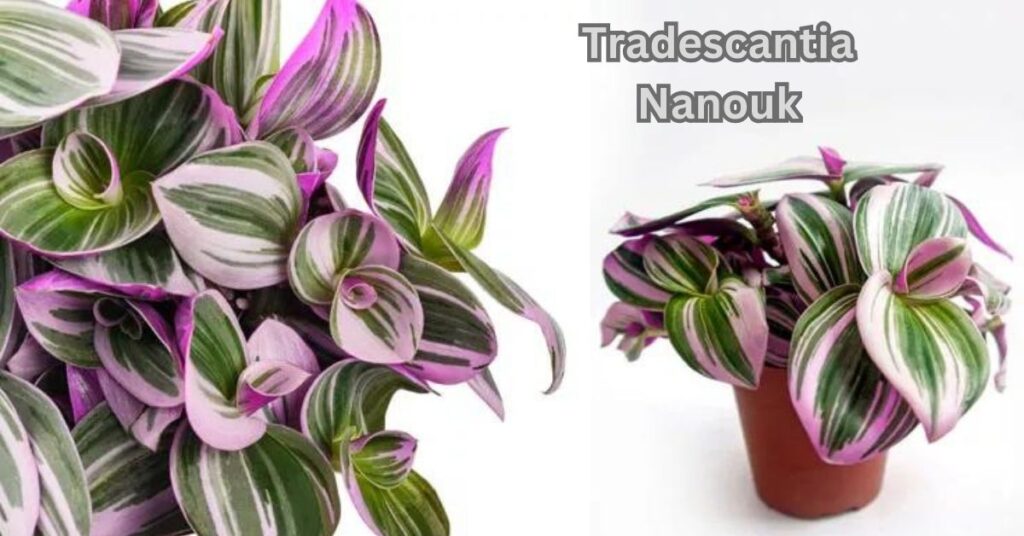Introduction
Tradescantia Nanouk, also known as Fantasy Venice, is a vibrant and hardy houseplant that has quickly become a favorite among plant enthusiasts. Known for its striking pink, purple, and green foliage, Tradescantia Nanouk is not only beautiful but also relatively easy to care for, making it an ideal choice for both beginners and seasoned gardeners. This guide will walk you through everything you need to know about this captivating plant, from its origins and characteristics to the best practices for keeping it healthy and thriving.
Understanding Tradescantia Nanouk
Origin and History
Tradescantia Nanouk is a cultivar of the Tradescantia genus, which includes many varieties of spiderworts. This particular variety was developed through cross-breeding to enhance its colorful and compact growth. Originating from the Netherlands, Tradescantia Nanouk has gained popularity worldwide due to its unique aesthetic and robust nature.
Unique Characteristics
What sets Tradescantia Nanouk apart from other houseplants is its vibrant, variegated leaves. The foliage displays a mix of pink, purple, and green, creating a stunning visual contrast. The plant also produces small, white or pink flowers, adding to its charm. Its thick, sturdy stems and compact growth habit make it a durable and attractive addition to any indoor garden.
Ideal Growing Conditions
Light Requirements
Tradescantia Nanouk thrives in bright, indirect light. It can tolerate lower light conditions, but its colors may not be as vibrant. Direct sunlight can scorch the leaves, so it’s best to place it near a window with filtered light or in a well-lit room away from direct sun exposure.
Temperature and Humidity
This plant prefers a warm environment with temperatures ranging from 65°F to 75°F (18°C to 24°C). Tradescantia Nanouk also enjoys higher humidity levels but can adapt to average household humidity. Using a humidity tray or misting the plant regularly can help maintain optimal conditions.
Soil Preferences
A well-draining soil mix is essential for Tradescantia Nanouk. A blend of regular potting soil with perlite or sand works well. Ensuring good drainage will help prevent root rot and other moisture-related issues.
Planting Tradescantia Nanouk
Choosing the Right Pot
Select a pot with drainage holes to prevent water from accumulating at the bottom. This will help avoid root rot and other moisture-related problems. A medium-sized pot is ideal, allowing room for growth while avoiding excessive soil moisture.
Soil Mix Recommendations
A light, well-draining soil mix is best for Tradescantia Nanouk. You can create your own by combining potting soil with perlite or sand. This will ensure proper aeration and prevent water from stagnating around the roots.
Planting Steps
- Fill the pot with the prepared soil mix, leaving space for the plant.
- Gently remove the plant from its current pot, being careful not to damage the roots.
- Place the plant in the new pot, adding soil around the roots to secure it in place.
- Water thoroughly, allowing excess water to drain out.
Watering and Feeding
Watering Schedule
Tradescantia Nanouk prefers consistent moisture but not waterlogged soil. Water when the top inch of soil feels dry. During the growing season (spring and summer), you may need to water more frequently. In the dormant season (fall and winter), reduce watering.
Signs of Overwatering and Underwatering
Overwatering can lead to root rot and yellowing leaves, while underwatering may cause the leaves to wilt and become dry. Pay attention to the soil moisture and adjust your watering schedule accordingly.
Fertilizing Tips
Feed Tradescantia Nanouk with a balanced, water-soluble fertilizer every 4-6 weeks during the growing season. Avoid over-fertilizing, as this can lead to nutrient burn and other issues.
Propagation Techniques
Propagating by Cuttings
Tradescantia Nanouk is easy to propagate through stem cuttings. This method allows you to create new plants from an existing one.
Step-by-Step Guide
- Select a healthy stem with several leaves.
- Cut a 4-6 inch section just below a node.
- Remove the lower leaves, leaving the top leaves intact.
- Place the cutting in water or directly into moist soil.
- Keep the cutting in a warm, bright location and maintain moisture.
- Roots should develop in a few weeks, and you can then transplant the cutting into its own pot.
Common Mistakes to Avoid
- Using a dull cutting tool: Always use a sharp, clean knife or scissors to make clean cuts.
- Overwatering cuttings: Ensure the soil is moist but not soggy to prevent rot.
- Insufficient light: Place cuttings in a well-lit area to promote healthy growth.
Pruning and Maintenance
Pruning Techniques
Regular pruning helps maintain the shape and encourages bushier growth. Trim back leggy stems and remove any dead or damaged leaves.
Removing Dead or Damaged Leaves
Remove yellowing or damaged leaves promptly to prevent disease spread and maintain the plant’s appearance.
Encouraging Bushier Growth
Pinch back the tips of the stems to encourage branching and fuller growth. This will result in a more compact and attractive plant.
Pest and Disease Management
Common Pests
Tradescantia Nanouk is generally resistant to pests but can occasionally attract spider mites, aphids, and mealybugs.
Signs of Disease
Watch for signs of fungal infections or rot, such as blackened stems or moldy soil.
Preventative Measures
- Regularly inspect the plant: Check for pests and disease symptoms.
- Maintain good air circulation: Avoid overcrowding and ensure adequate airflow around the plant.
- Water properly: Avoid waterlogging the soil, and use well-draining pots and soil.
Troubleshooting Common Problems
Yellowing Leaves
Yellow leaves can indicate overwatering or nutrient deficiencies. Adjust your watering schedule and consider feeding the plant with a balanced fertilizer.
Leggy Growth
Insufficient light can cause leggy growth. Move the plant to a brighter location and prune back overgrown stems.
Stunted Growth
Stunted growth may result from poor soil conditions or lack of nutrients. Repot the plant in fresh, well-draining soil and ensure it receives adequate light and nutrients.
Decorating with Tradescantia Nanouk
Styling Tips for Indoors
Tradescantia Nanouk makes a beautiful addition to any indoor space. Place it in hanging baskets, on shelves, or as a centerpiece on tables to showcase its vibrant colors.
Complementary Plants
Pair Tradescantia Nanouk with other colorful foliage plants like Calathea or Pothos to create a striking display.
Creative Container Ideas
Use decorative pots or repurpose containers like teacups or baskets to add a unique touch to your plant display.
Seasonal Care Tips
Adjusting Care for Different Seasons
Adjust your care routine based on the season to keep your Tradescantia Nanouk healthy year-round.
Winter Care
Reduce watering and ensure the plant is kept in a warm, well-lit area. Avoid placing it near drafts or heating vents.
Summer Care
Increase humidity and water more frequently. Protect the plant from direct sunlight to prevent leaf scorch.
Benefits of Tradescantia Nanouk
Aesthetic Appeal
Tradescantia Nanouk’s vibrant colors and unique foliage make it a stunning addition to any plant collection.
Air Purification
Like many houseplants, Tradescantia Nanouk helps purify the air by removing toxins and improving indoor air quality.
Easy Care
With proper care, Tradescantia Nanouk is a hardy and low-maintenance plant, perfect for beginners and busy plant lovers.
Buying Guide
Where to Buy Tradescantia Nanouk
You can find Tradescantia Nanouk at local nurseries, garden centers, or online plant retailers. Ensure you buy from reputable sources to get healthy plants.
Selecting Healthy Plants
Look for plants with vibrant, firm leaves and no signs of pests or disease. Avoid plants with yellowing or wilted foliage.
Price Range
Prices can vary based on the size and rarity of the plant. Expect to pay between $10 and $30 for a healthy Tradescantia Nanouk.
Sustainability and Environmental Impact
Sustainable Growing Practices
Opt for organic soil and fertilizers, and use sustainable watering practices to reduce your environmental footprint.
Eco-Friendly Potting Solutions
Consider using biodegradable pots or repurposing containers to create an eco-friendly growing environment for your Tradescantia Nanouk.
Conclusion
Tradescantia Nanouk is a versatile and attractive houseplant that brings a splash of color to any indoor space. Its unique foliage, ease of care, and air-purifying qualities make it a popular choice among plant enthusiasts. By following the tips and guidelines in this guide, you can ensure your TradescantiaNanouk thrives and continues to beautify your home.
FAQs
- How fast does TradescantiaNanouk grow?
- TradescantiaNanouk can grow fairly quickly, producing new leaves and stems within a few weeks under optimal conditions.
- Can TradescantiaNanouk be grown outdoors?
- While it can be grown outdoors in warm, frost-free climates, TradescantiaNanouk is typically grown as an indoor plant.
- Is TradescantiaNanouk toxic to pets?
- Yes, TradescantiaNanouk can be toxic to pets if ingested, causing gastrointestinal discomfort. Keep it out of reach of pets to ensure their safety.
- How often should I repot TradescantiaNanouk?
- Repot every 1-2 years or when the plant outgrows its current pot. Spring is the best time to repot.
- What should I do if my TradescantiaNanouk is losing color?
- Loss of color can result from insufficient light. Move the plant to a brighter location and ensure it receives indirect sunlight for several hours a day.







